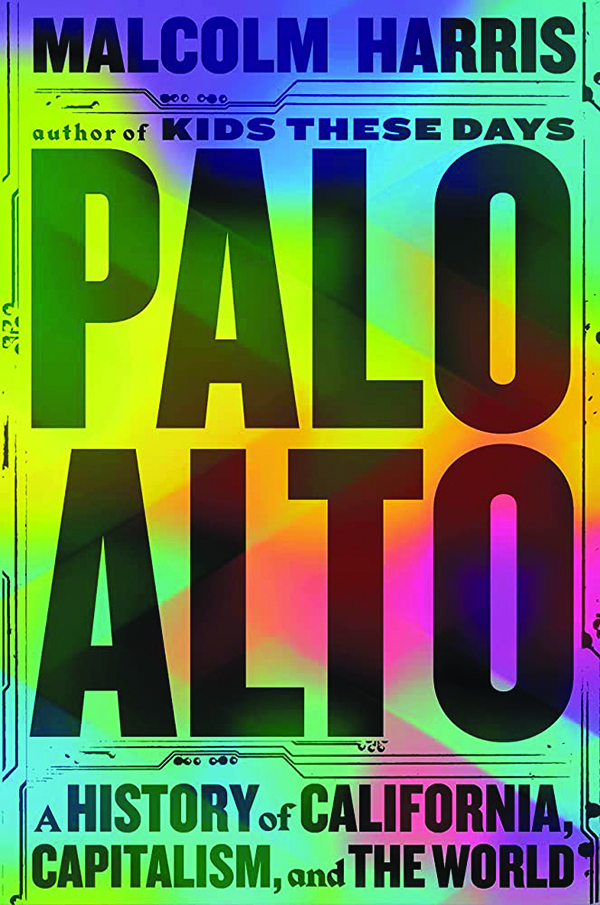
A flailing Marxist history of California, capitalist success story
Jason Willick
I regard my hometown of Palo Alto — once a sleepy middle-class suburb, now Silicon Valley’s globally renowned epicenter — with a mix of ambivalence and affection. Malcolm Harris, the author of the 700-plus page tome Palo Alto: A History of California, Capitalism, and the World, graduated from the city’s public high school a few years before I did. He and I both became writers, a relative rarity in a region built around science and engineering. But Harris regards Palo Alto with something it would be fair to describe as fanatical hatred.

In the book’s introduction, Harris refers to the well-publicized teenage suicides that have plagued Palo Alto since the early 2000s. The city’s rate of youth suicide has been significantly higher than the national average in the 21st century. Unsatisfied with the (admittedly unsatisfying) investigations of the scourge by journalists and the Centers for Disease Control and Prevention, Harris turns to Marxist political superstition: The suicides are revenge for Palo Alto’s capitalist sins, which have made the town “haunted.”
“Haunting connects the haunted” — that is, Palo Altans — “to unseen lineages of historical responsibility,” Harris explains. There are certain “social crimes from which some suffer and others profit.” In “hauntings,” the tables are turned, and the “profiteers are made to suffer.” The “violator’s descendants” may be held accountable for their ancestors’ actions. After all, many of the Palo Alto suicides have taken place on the same railroad “that brought the mass of capitalist white settlers to California,” a method that Harris deems “historically resonant.”
Like God in Exodus smiting the Egyptians, Harris suggests, history is expiating his hometown for its racist and capitalist exploitation. Examples of this exploitation — from the displacement of the region’s Native Americans to the degradation of the environment, to eugenics and the development of computer technology for the U.S. military — fill the rest of the book, in five chronological parts, from 1850 to 2020.
This one-note story is made somewhat more readable, at least, for being interspersed with a melange of Marxist metaphors, such as, “California’s agricultural capitalists pedaled the state’s nonwhite labor like a bicycle: When they pushed one group down, another rose to replace it, and the whole contraption moved a little farther down the road.” Later: “Silicon Valley leaders sat on top of this world system like a cherry on a sundae, insulated from the melting foundation by a rich tower of cream.” Harris is a vivid pamphleteer.
But let’s stick for a moment with the opening account of “historical responsibility” for the town’s suicides because it’s representative of the whole book’s victim-oppressor frame, in which history is a long train of abuses by the powerful, who may one day suffer their comeuppance. Who are the victims, and who are the oppressors? According to a 2016 report from Public Radio International, “40% of the students who died by suicide in Palo Alto were Asian American,” prompting the district to direct more resources toward those students. One of Palo Alto’s two high schools now has an Asian American plurality.
Harris’s story recounts the persecution of Asian Americans on the West Coast. For example, vigilantism against California Chinese was widespread in the 19th century, and an 1853 California Supreme Court case, People v. Hall, established that Chinese, like blacks and Indians, couldn’t testify against white Californians in court. (The legislature overturned the decision 20 years later.) Asian Americans couldn’t become naturalized U.S. citizens until the mid-20th century, and their ability to buy property, including in Palo Alto, was severely restricted. Harris tells the poignant stories of Yamato Ichihashi, Stanford’s first Japanese professor, whose station could not save him from an internment camp during World War II.
Readers who can withstand, or enjoy, Harris’s ideological bludgeon will learn some things about the region. For instance, One Flew Over the Cuckoo’s Nest, Ken Kesey’s 1962 novel that influenced 20th-century American perceptions of psychiatry, masculinity, and control, was inspired by Kesey’s experience working at a veterans’ hospital near Stanford, in a period when the CIA was funding experiments with LSD. Harris emphasizes the profound interconnectedness between Silicon Valley research and the World War II and Cold War national-security state. That relationship was partly forgotten in the post-Cold War era, but people are being forced to remember it as technological competition with China surges and Washington takes a greater interest in subsidizing and regulating microelectronics.
Harris’s explanations of scientific advances are detailed and punchy (cf. “Those pulses then got the next rhumbatron dancing as they transferred bursts of energy into the second cavity, like a wheel of fists against a dangling speed bag.”) But it doesn’t exactly build trust in science writing when the author announces ahead of time that his preferred explanation for a suicide cluster is residual “spiritual pain” inflicted by deceased capitalists.
One of Harris’s rhetorical tools is to describe social or moral problems and declare them to be “features, not bugs” of capitalism. “Competition and domination, exploitation and exclusion, minority rule and class hate: These aren’t problems capitalist technology will solve,” he explains. “That’s what it’s for.” Earlier: “For Amazon, injuries are efficient.” “Palo Alto has been unable to fix the problem of youth suicides because these youth suicides are already part of a solution.”
That means the exploitation and violence will only intensify until the whole system is overthrown, starting with the return of Stanford to the descendants of displaced Native Americans, to remedy Palo Alto’s original sin. “The return and critical refashioning of Stanford’s land is something like the minimum required action to preserve the possibility of a relatively peaceful transition to a sustainable world system,” Harris argues. And if that doesn’t happen? He gestures at Plan B by dedicating his book “to the planet Earth, its people, and its preservation by any means necessary.”
The flattening of history, the pining for revolution, and the erasure of the individual in favor of group categories: Perhaps these aren’t incidental to Marxism. They are features, not bugs — the outcomes it intends to achieve.
Jason Willick is an opinion columnist for the Washington Post.
